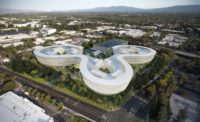After enduring several years of revenue declines, construction firms finally saw an increase in work during 2011, reflected in the $10.4-billion project value among the 25 projects ranked on ENR Southwest's Top Starts list. It was more than triple the total of 2010's top 25 starts, when only $2.9 billion of new work was generated for contractors and design firms in Arizona, Nevada and New Mexico.
The biggest single project start in 2011 was the $5-billion Intel Fab 42 Semiconductor Manufacturing Facility, located at Intel's existing campus in Chandler, Ariz. The plant design is nearly identical to Intel's new Hillsboro, Ore., plant, allowing for efficiencies of scale and standardization of components.
Construction of Fab 42 is employing "thousands" of workers who will accumulate more than 10.5 million man-hours through 2013, according to figures provided by Intel. Dominating the jobsite, the Sarens SGC-120—billed by the manufacturer as the world's largest land-based crane—uses its total boom length of 740 ft to hoist massive 325-ton, 160-ft-long steel roof trusses into place. The crane was delivered to the site in 250 truckloads and took eight weeks to assemble.
Construction of the facility will consume 150,000 cu yd of concrete, 24,000 tons of rebar, 875,000 cu yd of excavation and 175 miles of electrical conduit.
Intel's plant isn't the only manufacturing facility appearing on the list. First Solar, based in Tempe, Ariz., is constructing a $200-million solar panel manufacturing plant in neighboring Mesa, Ariz. German-owned firm M+W Group's Phoenix office is the general contractor.
The facility will include four manufacturing lines with a capacity to produce more than 250 MW of thin-film photovoltaic modules per year.
Renewable Power Surge
Renewable energy project starts dominated in 2011, with almost $3.8 billion in project value from six projects on the top 25 ranking. The largest solar project in 2011—and the largest ever for the state of Arizona—was the $1.6-billion Solana Solar Generating Station Plant in Gila Bend, which will convert 3 sq miles of agricultural land to a 250-MW facility with 2,700 parabolic trough collectors.
Nevada's first wind project got under way in August 2011 at the 150-MW Spring Valley Wind Farm and Electrical Substation on remote Bureau of Land Management land about 30 miles outside of the small town of Ely. Due to the environmental sensitivity of the site, the crew of 150 workers at peak has kept earth moving and land disturbance to a minimum during construction of roads and foundations for the 66 Seamans 2.3-MW wind turbines. Building information modeling has been used to sequence the construction and to minimize land disturbance, says Kevin Deters, general manager of Minneapolis-based Mortenson Construction's wind group. While BIM has been used extensively on the contractor's building side, it was the first use of BIM by the wind group.




























